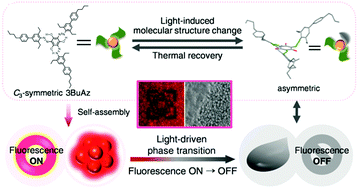A trigonal molecular assembly system with the dual light-driven functions of phase transition and fluorescence switching†
Abstract
The design of light-responsive fluorescent assembly systems with a variety of photochemical and photophysical properties is important for the fundamental understanding of the assembly–disassembly process as well as for applications such as optical information storage and fluorescence sensing. A major obstacle in constructing such photofunctional materials is the lack of a molecular design strategy for photoswitchable organic chromophores with aggregation-induced emission/aggregation-induced emission enhancement (AIE/AIEE) characteristics. Herein, we describe a new trigonal azobenzene framework showing AIE/AIEE characteristics and excellent photoisomerization (∼90%) from the C3-symmetric to asymmetric (including a bent-shaped cis-azobenzene) form. NMR experiments demonstrate light-induced molecular structure changes, which cause drastic symmetry breaking. The trigonal chromophores assemble into red fluorescent microspheres and their fluorescence intensity increases by ∼10-fold, confirming the AIE/AIEE characteristics. Importantly, scanning electron microscopy (SEM), optical microscopy (OM), and fluorescence optical microscopy (FOM) images substantiate that a noticeable light-driven melting occurs simultaneously with a marked fluorescence switching from on to off. Moreover, the fluorescent spheres are successfully applied in optical information storage and fluorescence sensing in a non-contact fashion.



 Please wait while we load your content...
Please wait while we load your content...